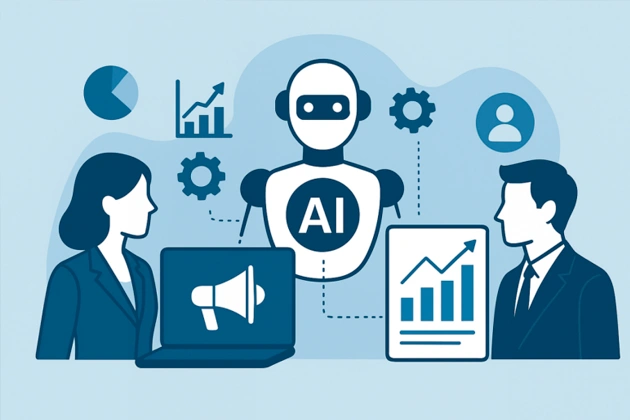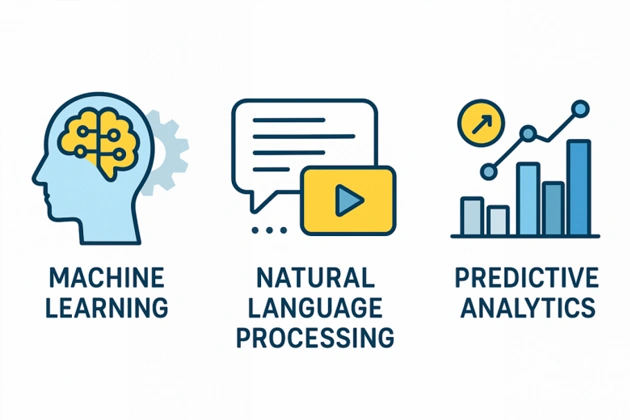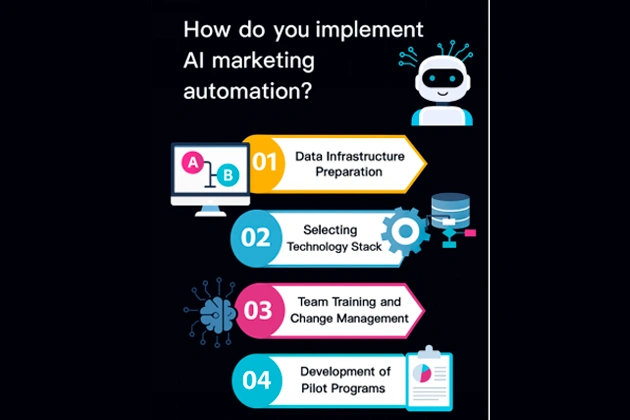Did you know that 80% of marketers applying AI have increased leads, and firms adopting AI marketing automation have up to 451% rise in qualified leads? However, the vast majority of enterprises are still using the same generic message email to as many as thousands of clientele—such as speaking into a megaphone in a library when you could whisper in an individual person’s ear and get them to listen to what you have to say.
The contemporary marketer who adopts the use of AI in marketing automation has a chance to access very potent tools that are able to process large volumes of customer data, forecast customer behavior, and engage in direct target campaigns with the precision of a scalpel. This technology is not the one that simply automates some repetitive activities, but it changes the way businesses perceive and interact with their audiences.
Understanding AI Marketing Automation
Marketing automation through AI fundamentally transforms the way companies interact with customers by incorporating intelligence into their conventional marketing processes. AI-driven systems are not dependent on rules like a traditional automation system, but learn the patterns of data and continuously optimize performance.
In its most basic form, AI marketing automation is a collection of various technologies capable of being combined such as machine learning, natural language processing, predictive analytics and computer vision. Companies are also moving towards the use of tools that offer complete enterprise AI solutions by deploying AI agents in customer support, enterprise search, data insights, etc.
The system handles large amounts of information in one or more of the following touchpoints such as website interaction, email interaction, social media interaction, purchase history, and demographic data.
Key Components of AI Marketing Systems
The intelligent marketing automation is based on machine learning algorithms that allow systems to detect the tendencies in customer behavior and optimize the work of the campaign in a continuous manner.
- Machine Learning: Decodes behavioral trends, converting events, time of purchase and content to streamline campaigns.
- Natural Language Processing (NLP): Provides customized email, chatbots and social replies that are natural and relevant.
- Predictive Analytics: Estimates lifetime value of customers, churn risk as well as the best time to engage in customer interaction to enhance the allocation of resources.
This enables every business to better plan resource allocation and make the most out of the marketing activities.
How Does AI Transform Traditional Marketing Automation?
The previous model of automation in marketing was very reliant on the strict and pre-determined workflows which considered all customers in the segment as the same. Although they worked in simple campaigns, these systems were not advanced enough to adjust to the preferences of individual customers and evolving market circumstances.
AI marketing automation lays down the basis of dynamic, smart processes that can be modified on the fly in response to customer behavior and external dynamics. Rather than pursuing predefined routes, AI-driven solutions constantly monitor how customers interact and modify messages, timing and channel placement to maximize their engagement.
Greater Customization of the Product
AI will change personalization into a more advanced level of behavioral prediction, as compared to the simple demographic targeting. The technology dissects the individual customer journeys, discerning unique preferences, pain points, and decision-making trends that feed highly target messaging.
The generation of dynamic content guarantees that every customer will get the relevant and timely information which will consider their needs and interests. Such a personal approach to a customer drastically increases the rates of engagement and conversion.
Real-time optimization enables AI to make immediate corrections to campaigns after receiving performance data so that they are as efficient and effective as possible all through the customer experience.
Smart Customer Journey Mapping
AI expands elaborate customer journey maps that are developed on the basis of real-life behavior as opposed to assumptions. Such dynamic maps help to determine the best touchpoints to engage with and anticipate the best messaging to use at each phase of the buyer journey.
The technology identifies micro-moments in the customer journey where precise interventions can make a huge difference in purchase decisions and marketers can provide the appropriate message at the appropriate time.
Practical Steps to Implement AI Marketing Automation Successfully
The implementation of the ailing marketing automation with AI is a process that should be planned carefully, thought, and implemented systematically. The first step is to complete the evaluation of the existing marketing processes and define the spheres where AI could have the most significant effect.
Step 1: Data Infrastructure Preparation
Businesses faced with deploying AI marketing automation need to have solid systems of data collection and management in place. This involves the incorporation of many data sources like CRM, web-based analytics, email, and social networking tools to form a standardized customer data platform.
Step 2: Selecting Technology Stack
Selection of appropriate AI marketing automation platforms needs a thorough screening on the basis of business requirements, financial limitations and technical requirements. The factors to consider include integration capabilities, scalability, user interface design, and quality customer support.
- Compare several suppliers and demand close demonstration of products and services available in the market at the time
- Compare integration opportunities with existing marketing tools
- Think about scaling and expansion opportunities in the long term
Step 3: Team Training and Change Management
To be successful in the implementation of AI, it will be essential to have an extensive training program that will enable marketing teams to know and exploit new opportunities. This involves technical learning on how to use the platform and strategic learning on the concepts of AI-driven marketing.
The change management programs must be used to counter the possible anti-automation attitudes and underline that AI supports human creativity and strategic thinking instead of the latter.
Step 4: Development of Pilot Programs
Begin with small pilot projects that can explore the capabilities of AI in particular fields like email marketing or lead scoring. Such controlled experiments give important information on the functionality of the systems and can identify the position of optimization.
Use cases:
- Start with low-risk, high-impact use cases
- Build clear metrics and measurement frameworks
- Document lessons learned to scale to more use cases
Uninterrupted observational and optimization mean that the AI marketing automation system can provide the greatest benefits in the long term. Periodic performance analysis is used to determine the areas of improvement and the strategic modifications of the campaign strategies.
Conclusion
AI marketing automation is the future of online marketing, with more than ever before businesses having the opportunity to build more effective, efficient and personalized customer experiences. With the help of integrating artificial intelligence with traditional marketing automation, the companies are able to generate incredible campaigns, customer and profit optimization.
The shift to AI-based marketing automation needs a strategic approach, execution, and constant optimization. Nevertheless, companies that effectively adopt this technology achieve great competitive advantages because of enhanced personalization, predictive power, and operational effectiveness.












